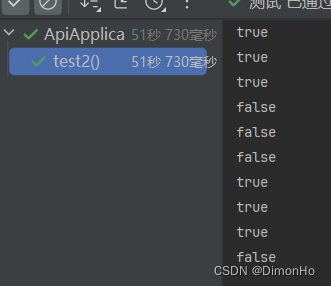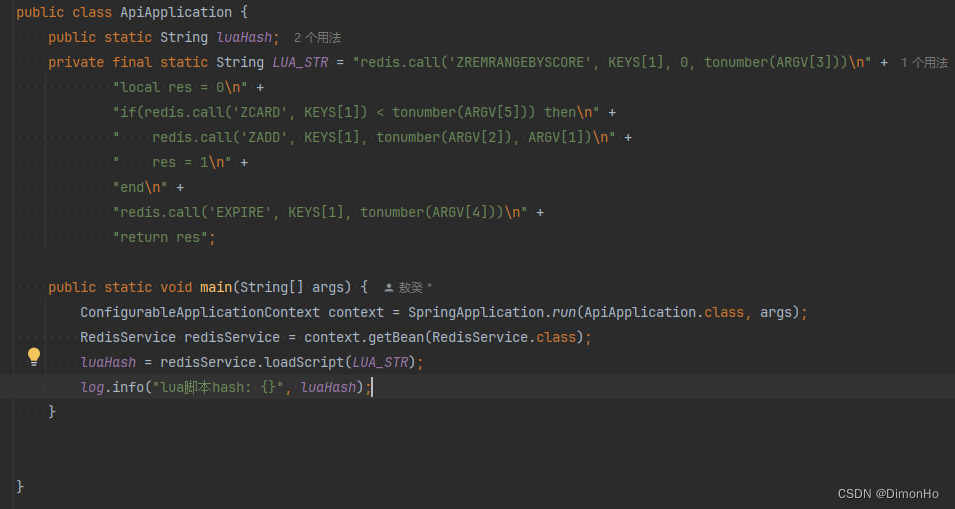需求背景:
限制某sql在30秒内最多只能执行3次
需求分析
微服务分布式部署,既然是分布式限流,首先自然就想到了结合redis的zset数据结构来实现。
分析对zset的操作,有几个步骤,首先,判断zset中符合rangeScore的元素个数是否已经达到阈值,如果未达到阈值,则add元素,并返回true。如果已达到阈值,则直接返回false。
代码实现
首先,我们需要根据需求编写一个lua脚本
1 2 3 | redis.call('ZREMRANGEBYSCORE', KEYS[1], 0, tonumber(ARGV[3]))local res = 0if(redis.call('ZCARD', KEYS[1]) |
ARGV[1]: zset element
ARGV[2]: zset score(当前时间戳)
ARGV[3]: 30秒前的时间戳
ARGV[4]: zset key 过期时间30秒
ARGV[5]: 限流阈值
1 2 3 4 5 6 7 8 | private final RedisTemplate redisTemplate;public boolean execLuaScript(String luaStr, List keys, List<object data-origwidth="" data-origheight="" style="width: 1264px;"> args){ RedisScript redisScript = RedisScript.of(luaStr, Boolean.class) return redisTemplate.execute(redisScript, keys, args.toArray());}</object> |
测试一下效果
1 2 3 4 5 6 7 | @SpringBootTestpublic class ApiApplicationTest { @Test public void test2() throws InterruptedException{ String luaStr = "redis.call('ZREMRANGEBYSCORE', KEYS[1], 0, tonumber(ARGV[3]))n" + "local res = 0n" + "if(redis.call('ZCARD', KEYS[1]) |

测试结果符合预期!
扩展阅读
lua脚本每次都需要传一长串脚本内容来回传输,会增加网络流量和延迟,而且每次都需要服务器重新解释和编译,效率较为低下。因此,不建议在实际生产环境中直接执行lua脚本,而应该使用lua脚本的hash值来进行传输。
为了方便使用,我们先把方法封装一下
1 2 3 4 5 6 7 8 9 10 11 12 13 14 15 16 17 18 19 20 21 22 23 24 25 26 27 28 29 30 31 32 33 34 35 36 37 38 39 40 41 42 43 44 45 46 47 48 49 50 51 52 53 54 55 56 57 58 59 60 61 62 63 64 65 66 67 68 69 70 71 72 73 | import lombok.RequiredArgsConstructor;import org.springframework.data.redis.connection.RedisScriptingCommands;import org.springframework.data.redis.connection.ReturnType;import org.springframework.data.redis.core.RedisTemplate;import org.springframework.data.redis.serializer.RedisSerializer;import org.springframework.stereotype.Component;import java.util.List;/** * @author 敖癸 * @formatter:on * @since 2024/3/25 */@Component@RequiredArgsConstructorpublic class RedisService { private final RedisTemplate redisTemplate; private static RedisScriptingCommands commands; private static RedisSerializer keySerializer; private static RedisSerializer valSerializer; public String loadScript(String luaStr) { byte[] bytes = RedisSerializer.string().serialize(luaStr); return this.getCommands().scriptLoad(bytes); } public T execLuaHashScript(String hash, Class returnType, List keys, Object[] args) { byte[][] keysAndArgs = toByteArray(this.getKeySerializer(), this.getValSerializer(), keys, args); return this.getCommands().evalSha(hash, ReturnType.fromJavaType(returnType), keys.size(), keysAndArgs); } private static byte[][] toByteArray(RedisSerializer keySerializer, RedisSerializer argsSerializer, List keys, Object[] args) { final int keySize = keys != null ? keys.size() : 0; byte[][] keysAndArgs = new byte[args.length + keySize][]; int i = 0; if (keys != null) { for (String key : keys) { keysAndArgs[i++] = keySerializer.serialize(key); } } for (Object arg : args) { if (arg instanceof byte[]) { keysAndArgs[i++] = (byte[]) arg; } else { keysAndArgs[i++] = argsSerializer.serialize(arg); } } return keysAndArgs; } private RedisScriptingCommands getCommands() { if (commands == null) { commands = redisTemplate.getRequiredConnectionFactory().getConnection().scriptingCommands(); } return commands; } private RedisSerializer getKeySerializer() { if (keySerializer == null) { keySerializer = redisTemplate.getKeySerializer(); } return keySerializer; } private RedisSerializer getValSerializer() { if (valSerializer == null) { valSerializer = redisTemplate.getValueSerializer(); } return valSerializer; }} |
- 测试一下:
1 2 3 4 5 6 7 8 9 10 11 12 13 14 15 16 17 18 | @SpringBootTest@TestInstance(TestInstance.Lifecycle.PER_CLASS)public class ApiApplicationTest implements ApplicationContextAware { private static ApplicationContext context; private static RedisService redisService; public static String luaHash; private final static String LUA_STR = "redis.call('ZREMRANGEBYSCORE', KEYS[1], 0, tonumber(ARGV[3]))n" + "local res = 0n" + "if(redis.call('ZCARD', KEYS[1]) keys = Collections.singletonList("aaaa"); Object[] args = new Object[]{"ele" + i, System.currentTimeMillis(), System.currentTimeMillis() - 30 * 1000, 30, 3}; Boolean b = redisService.execLuaHashScript(luaHash, Boolean.class, keys, args); System.out.println(b); Thread.sleep(3000); } }} |
使用的时候在项目启动时候,把脚本load一下,后续直接用hash值就行了

搞定收工!
以上就是利用redis lua脚本实现时间窗分布式限流的详细内容,更多关于redis lua时间窗分布式限流的资料请关注IT俱乐部其它相关文章!

